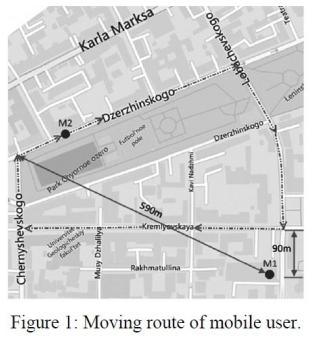Being the most popular type of wireless systems, the cellular communications continuously increase their demands for confidentiality of traffic data of mobile subscribers. The Wireless Key Distribution is one of the most promising and fast growing areas in modern applied cryptography.
 A pair of identical transceiving test devices (M1 and M2) has been designed to implement the experimental verification. The M1 test device was placed at the 14th floor of our research facility at approximately 45 meters above the mean roof height to serve as a base station. The M2 test device was placed into a car to be moved on the closed route within the surrounding urban environment.
A pair of identical transceiving test devices (M1 and M2) has been designed to implement the experimental verification. The M1 test device was placed at the 14th floor of our research facility at approximately 45 meters above the mean roof height to serve as a base station. The M2 test device was placed into a car to be moved on the closed route within the surrounding urban environment.
The area covers various techniques of secure secret key distribution between two legitimate users who share a common radio channel with unpredictable signal fading in a multipath environment.
The experiments conducted byresearchers of the Department of Radio Physics can be considered as the first experimental verification of secure Wireless Key Distribution by observing random variations from the fluctuations of carrier phase of the received signal between two legitimate nodes with a common multipath channel placed into the moving cars within a real outdoor environment.
According to the researchers, the measurements of signal carrier phase could be more appropriate for cryptographic applications because the approach has at least three valuable benefits:
Firstly, the probability distribution of carrier phase is usually closer to uniform as opposed to the distribution of the received signal strength indication (RSSI). Secondly, the RSSI based method is mainly limited to a fixed link length communication scenario. Finally, the phase measurements have the ambiguity property making key interception more complicate in practice.
To perform the experiment, researchers used wireless Internet transmission of concurrent service data to maintain a required level of synchronization of one stationary and one mobile legal node. During the data collecting procedure the nodes kept on transmitting the sounding signals at the carrier frequency f = 963 MHz in a time-division duplex mode.
"The key generation rate about RK ~ 0.1 bits per second (bps) has been achieved at satisfactory statistical properties of the generated key, which sequence also satisfies the criteria of randomness. Despite the humble key generation rates achieved in practice, we believe in a great potential of the method for secure wireless key distribution between the base station and mobile subscriber in a cellular communications scenario.
We succeeded in our goal, but a further wireless synchronization enhancement is required to achieve better system performance." says Prof. Arkadiy Karpov.